| Article ID | Journal | Published Year | Pages | File Type |
|---|---|---|---|---|
| 11028532 | Aeolian Research | 2018 | 11 Pages |
Abstract
In this study, the climbing dunes in the Qinghai-Tibet Plateau were digitalized through Google Earth images and field examinations in order to facilitate the investigation of their distribution patterns and to allow their classification. The results of this study showed that the total area covered by climbing dunes in the Qinghai-Tibet Plateau is about 30,075â¯km2, which represents 7.5% of the total area of aeolian landforms in the plateau, and 1.15% of the entire plateau area. The climbing dunes of the Qinghai-Tibet Plateau were densely distributed in the Qaidam Basin, Gonghe Basin, Kumukuri Basin, foothills of the Qilian Mountains, foothills of the Altun Mountains, and the Southern Tibet Valley. Sporadic distributions were also observed in the river and lake basins of the Hengduan Mountains, Qiangtang Plateau, and the Ali Plateau. The average climbing height of the climbing dunes in the Plateau was 191â¯m, with the maximum and minimum climbing height being 1416â¯m and 3â¯m, respectively. Based on morphogenetic principles, we have established a classification diagram for climbing dunes of the Qinghai-Tibet Plateau; on going from the base of a slope to the crest, the morphologies of the dunes increased in complexity and the age of their formation grows earlier. The development of climbing dunes is related to interactions between wind regime, sand materials, dry climate, undulating terrain and accommodation space. The research results of the climbing dunes on the Qinghai-Tibet Plateau could contribute to the understanding of aeolian landforms.
Related Topics
Physical Sciences and Engineering
Earth and Planetary Sciences
Atmospheric Science
Authors
Miao Dong, Ping Yan, Baoli Liu, Wei Wu, Xiaonan Meng, Xinran Ji, Yong Wang, Yijiao Wang,
